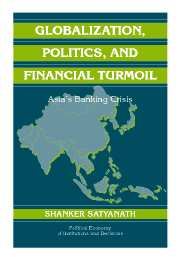Book contents
- Frontmatter
- Contents
- Figures and Tables
- Preface
- GLOBALIZATION, POLITICS, AND FINANCIAL TURMOIL
- 1 Introduction
- 2 Bank Regulation in the Debate over Capital Flow Liberalization
- 3 The Signaling Argument
- 4 Incredible Signaling in Democracies: The Cases of Thailand, South Korea, and the Philippines
- 5 Unorthodox Solutions to the Signaling Problem: The Cases of Malaysia and Indonesia
- 6 Orthodox Solutions to the Signaling Problem: The Cases of Singapore and Hong Kong
- 7 Some Concluding Remarks
- Appendix I The World Bank's Evaluation of Bank Regulatory Environments
- Appendix II Verbal Description of the Equilibrium with Two Signalers
- Appendix III Formal Proof of Equilibrium with Two Signalers
- Bibliography
- Interviews by the Author
- Index
- POLITICAL ECONOMY OF INSTITUTIONS AND DECISIONS
3 - The Signaling Argument
Published online by Cambridge University Press: 24 July 2009
- Frontmatter
- Contents
- Figures and Tables
- Preface
- GLOBALIZATION, POLITICS, AND FINANCIAL TURMOIL
- 1 Introduction
- 2 Bank Regulation in the Debate over Capital Flow Liberalization
- 3 The Signaling Argument
- 4 Incredible Signaling in Democracies: The Cases of Thailand, South Korea, and the Philippines
- 5 Unorthodox Solutions to the Signaling Problem: The Cases of Malaysia and Indonesia
- 6 Orthodox Solutions to the Signaling Problem: The Cases of Singapore and Hong Kong
- 7 Some Concluding Remarks
- Appendix I The World Bank's Evaluation of Bank Regulatory Environments
- Appendix II Verbal Description of the Equilibrium with Two Signalers
- Appendix III Formal Proof of Equilibrium with Two Signalers
- Bibliography
- Interviews by the Author
- Index
- POLITICAL ECONOMY OF INSTITUTIONS AND DECISIONS
Summary
In this chapter, I demonstrate why a small difference in preferences between the chief executive and financial bureaucrats renders signals vague. I also show why the threshold difference in preferences between the chief executive and signalers that generates completely uninformative signals is relatively low in the realm of bank regulation. I begin by defining some terms. I then describe the logic that links a significant difference in preferences between the chief executive and the central bank governor to lax regulation, when the governor is the sole signaler of information collected by bank supervisors. In Section 3.3, I address the scenario in which both the central bank governor and the finance minister are signalers.
DEFINING SOME TERMS
Banking Sector Robustness
The signaling models presented here focus on a key aspect of a banking sector's robustness: the degree to which a banking sector is capitalized relative to expected loan defaults. I focus on this aspect of robustness for the signaling model because signaling considerations are important in realms where some actors have private information, and this condition is often likely to be met when it comes to the relationship between capitalization and expected defaults, for the reasons listed in Chapter 1.
As per the principles of bank accounting, a bank that has a shareholder capital buffer that is insufficiently large to cover loan defaults is considered to be insolvent.
- Type
- Chapter
- Information
- Globalization, Politics, and Financial TurmoilAsia's Banking Crisis, pp. 28 - 47Publisher: Cambridge University PressPrint publication year: 2005

